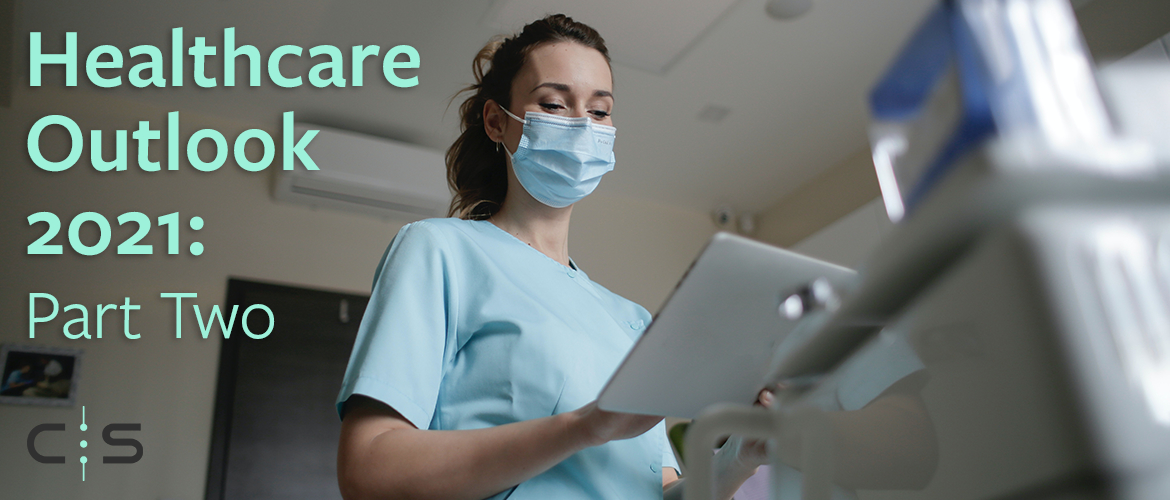
This is Part Two of our Healthcare Outlook for 2021. You can read Part One here.
In part one of our Healthcare Outlook, we looked at evolving tech needs around COVID and the movement toward interoperability accelerated by the 21st Century Cures Act. In part two, we’re focusing on how the success of telehealth is driving the further consumerization of healthcare, and the shift in senior care to home-based care, along with what these trends mean for healthcare solution providers.
Telehealth and the Consumerization of Healthcare
While telehealth — the use of digital information and communication technologies to enable remote healthcare services and management of care — was already on the rise going into 2020, COVID brought it to the forefront as patients were unable to visit providers’ offices in person for non-urgent issues. According to the CDC, “During the first quarter of 2020, the number of telehealth visits increased by 50%, compared with the same period in 2019” (CDC MMWR, Oct. 30, 2020). We expect the popularity of telehealth to continue to grow in 2021 and beyond.
The possibilities and benefits of telehealth go beyond enabling virtual appointments and reducing exposure to COVID for healthcare staff and patients during the pandemic, though these have been invaluable throughout the pandemic. Telehealth technologies can also expand access to care for people who live in rural, isolated, or otherwise underserved communities; reduce overall healthcare costs; and improve communication and coordination between provider teams and patients.
With the success of telehealth in 2020, we’ll see this trend expand to deliver even more tech-enabled options for both patients and providers. Compounded by the improved interoperability and access to health information we’ll see as a result of the Cures Act (which we covered in part one of this blog), this will dramatically accelerate the consumerization of healthcare.

The Amazon Effect is coming to healthcare, and it will affect every aspect of the industry. Today’s patients are also consumers who have become accustomed to convenience and instant gratification. These healthcare consumers want real-time, on-demand health updates; modern, user-friendly apps to help them access and manage their health information and care on any device; visibility into the costs, options, and results of their care; and the ability to quickly and easily receive care on their own schedule.
The challenge (and opportunity!) for healthcare providers and solution providers is how to meet these increasing demands to make healthcare more personalized, accessible, and convenient, along with how to improve quality of care and customer service — without increasing costs — to remain competitive as patients gain more healthcare choices, as well as control over those choices.
Senior Care Shift to Home-based Care
One of the areas where the COVID-19 pandemic, the movement toward interoperability, the rise of telehealth, and the consumerization of healthcare are combining to drive a paradigm shift is Senior Care. More and more, healthcare for aging populations is moving to in-home care, and we expect to see that trend grow in 2021.
Home care can include any professional in-home or virtual services that enable seniors to live safely and independently in their own home, whether they’re recovering from a medical procedure or injury, managing a chronic condition, living with a disability, or simply dealing with short-term illness. The COVID-19 pandemic accelerated the trends of senior care moving from hospitals to skilled nursing facilities (SNFs) and an increase in SNF-to-home diversions. As telehealth and virtual appointments become more commonplace, seniors are able to remain in their homes longer, while still getting the care they need.

One of the challenges that comes with this trend is that home care providers — traditionally a very fragmented industry that includes a lot of small businesses and mom-and-pop operators — need to be able to access health information and manage care remotely, where the care is being provided. At its core, the challenge is the same as it is in the broader healthcare arena: how to connect the patient to the right care at the right time.
There are opportunities here for healthcare organizations that can help steer and coordinate this decentralization of senior care. Opportunities also exist around empowering seniors to easily manage their own care and their growing options for in-home services, from newly available telehealth care to on-demand companionship services and smart home device-enabled health monitoring. Because the home care industry is fragmented, it has traditionally proven difficult to scale, but here again there is opportunity for organizations that can centralize information and build scalable apps to better coordinate care.
What This Means for Healthcare Organizations
Building or replatforming on Salesforce can enable healthcare organizations to swiftly meet the challenges of today’s rapidly shifting healthcare landscape by leveraging the specific capabilities and investments in Health Cloud and the scalable infrastructure, security, connectivity, and flexibility of the Salesforce platform.
With our deep knowledge of the Salesforce Platform and Health Cloud, along with our proven experience building scalable applications for healthcare providers, CodeScience can help healthcare orgs build or connect existing applications quickly and cost-effectively to create a more personalized, connected, and intuitive experience for today’s modern healthcare consumers.
We’ve mastered the science of building healthcare applications for commercial success. Contact us today to learn how we can help transform your toughest healthcare challenges into your best and brightest revenue opportunities.


